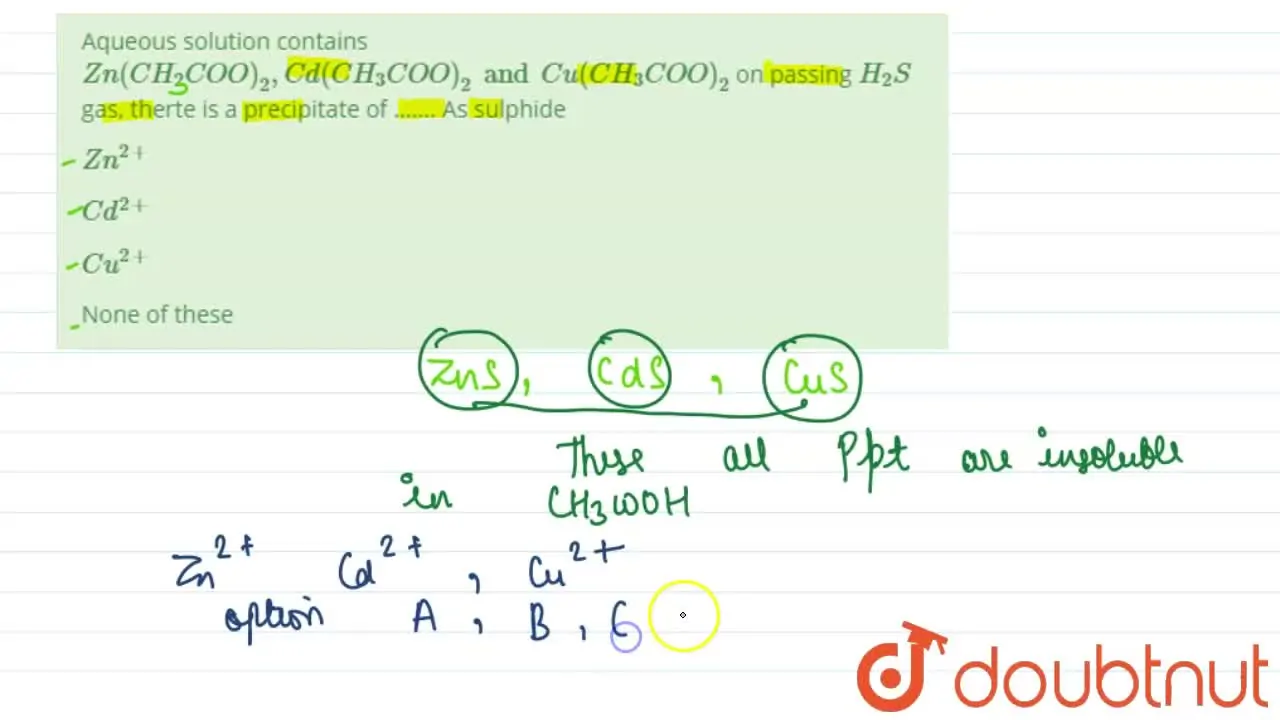Aqueous solution contains Zn(CH2COO)2,Cd(CH3COO)2andCu(CH3COO)2 on passing H2S gas, therte is a precipitate of ……. As sulphide
Zn2+
Cd2+
Cu2+
None of these
The correct Answer is:a,b,c
Step by step video & image solution for Aqueous solution contains Zn(CH_(2)COO)_(2),Cd(CH_(3)COO)_(2) and Cu(CH_(3)COO)_(2) on passing H_(2)S gas, therte is a precipitate of ……. As sulphide by Chemistry experts to help you in doubts & scoring excellent marks in Class 12 exams.
Related Playlists
- BOOK - CENGAGE CHEMISTRY ENGLISHCHAPTER - QUALITATIVE INORGANIC SALT ANALYSISEXERCISE - Exercises (Multiple Correct) Part-C(Dry Test)8videos
QUALITATIVE INORGANIC SALT ANALYSIS
- BOOK - CENGAGE CHEMISTRY ENGLISHCHAPTER - QUALITATIVE INORGANIC SALT ANALYSISEXERCISE - Exercises (Multiple Correct) Part-D (Miscellaneous)20videos
QUALITATIVE INORGANIC SALT ANALYSIS
- BOOK - CENGAGE CHEMISTRY ENGLISHCHAPTER - QUALITATIVE INORGANIC SALT ANALYSISEXERCISE - Exercises (Multiple Correct) Part-A (Analysis Of Anions)30videos
QUALITATIVE INORGANIC SALT ANALYSIS
- BOOK - CENGAGE CHEMISTRY ENGLISHCHAPTER - P-BLOCK GROUP 18 ELEMENTS - THE INERT GASESEXERCISE - Ex 5.1 (Objective)14videos
P-BLOCK GROUP 18 ELEMENTS - THE INERT GASES
- BOOK - CENGAGE CHEMISTRY ENGLISHCHAPTER - REDUCTION AND OXIDATION REACTION OF ORGANIC COMPOUNDSEXERCISE - SUBJECTIVE TYPE4videos
REDUCTION AND OXIDATION REACTION OF ORGANIC COMPOUNDS
Similar Questions
(CH3COO)2Ca+(HCOO)2CaHeat−−→
View SolutionThe coordination number of Cr in Cr3O(CH3COO)63H2Ois,
View SolutionIn vapour state Cu(NO3)2 and Cu2(CH3COO)4.2H2O exist as
View SolutionCH3COO− ion is more stable than C2H5O− ion. Assign reason.
View SolutionThe strongest conjugate base is
(a) NO−3
(b)Cl−
(c)SO2−4
(d)CH3COO−View SolutionA solution of aqueous of KOH hydrolysis CH3CHClCH2CH3andCH3CH2CH2CH2Cl. Which one of these is more easily hydrolysed.?
View SolutionOn passing CrO2Cl2 in water and then adding (CH3COO)2Pb, the precipitate formed is
View SolutionCalculate the pH of a solution containing 0.1 M CH3COOH
and 0.15 M CH3COO−.
(KaofCH3COOH=1.8×10−5)View SolutionIf CH2COOH+OH−→CH3COO−+H2O+q1
H++OH−→H2O+q2
then the enthalpy change for the equal toView SolutionComplete the following reaction :
(CH3CH2COO)2Caheat−−→View Solution


